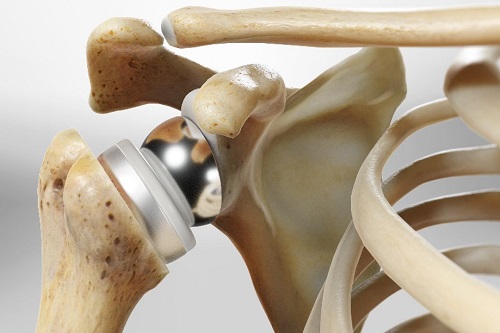Reverse Shoulder Arthroplasty

A reverse total shoulder replacement is a unique surgical procedure aimed at addressing shoulder issues. During this surgery, the surgeon removes damaged components of the shoulder and substitutes them with artificial counterparts.
The shoulder joint comprises the upper arm bone (humerus) and the shoulder blade (scapula). The rounded end of the upper arm bone, known as the humeral head or ball, articulates within a shallow socket in the shoulder blade.
This anatomical arrangement allows the shoulder to exhibit a broad range of motion. Additionally, support and smooth movement of the joint are facilitated by cartilage, tendons, and ligaments surrounding it.
What is the difference between a reverse and standard shoulder replacement?
In a reverse prosthesis, the key distinction from a standard shoulder replacement lies in the placement of the components. Here, the ball is positioned on the socket side of the joint, contrary to its natural location, hence the term “reverse.” Conversely, in a standard procedure, the metal ball attaches to the upper part of the humerus, while the plastic socket is affixed to the shoulder blade, more closely mimicking a person’s actual anatomy.
What shoulder conditions warrant reverse total shoulder replacement?
Rotator cuff tear arthropathy often prompts consideration of a reverse prosthesis, especially when arthritis affects the shoulder joint and the rotator cuff tendons are compromised or absent. This type of prosthesis can substantially alleviate pain and partially restore shoulder mobility.
In cases of extensive rotator cuff tears where lifting the arm adequately becomes challenging, a reverse prosthesis may offer a solution to regain motion and functionality. This condition is often characterized by anterior-superior migration or subluxation of the shoulder, resulting in difficulty lifting the arm despite minimal pain.
Patients who continue to experience symptoms following a standard shoulder replacement, such as persistent pain and limited range of motion, may benefit from a reverse total shoulder replacement. However, transitioning to a reverse prosthesis after a standard replacement entails a complex surgical procedure involving the removal of the existing shoulder prosthesis.
Certain shoulder fractures, particularly those near the attachment point of the arm bone’s ball to its shaft (humerus), may necessitate a reverse prosthesis. Severe fractures, where the bone is fragmented or the ball is fractured into multiple pieces, may require this intervention.
In instances of proximal humerus tumors affecting the bone shaft or the humeral ball itself, a reverse prosthesis may be indispensable for restoring shoulder function.
